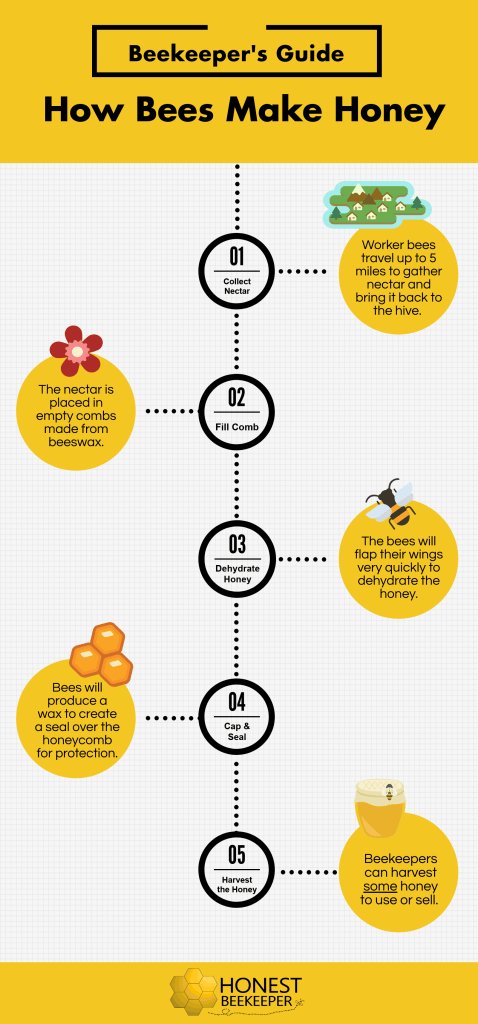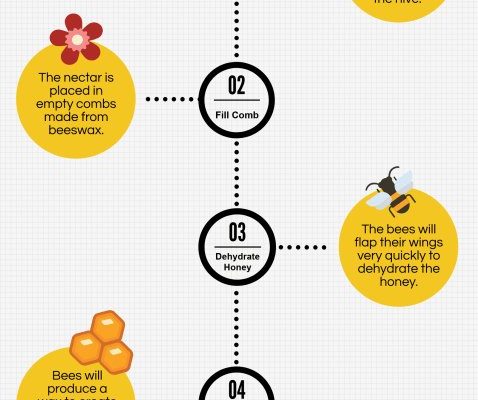
Bees are nature’s little miracle workers. They gather nectar from flowers, perform a bit of magic inside their hives, and voilà—honey! Whether you’re a curious mind or just someone who enjoys honey in your tea, understanding how bees make honey is a wonderful journey into the heart of nature. So grab a cup of coffee or tea, and let’s explore each step of this buzzing process.
1. The Role of Worker Bees
Let’s start with the heroes of our story: the worker bees. These female bees are the heart and soul of the hive. They’ve got a lot on their plates, from foraging for nectar to tending to the queen and the larvae. It’s like having a team of busy chefs in a kitchen, all working together to create something special.
When it’s time to collect nectar, worker bees take to the skies. They can travel up to 5 miles from the hive, landing on flowers to gather nectar, which is a sugary liquid that plants produce to attract pollinators. Think of nectar as the sweet juice of a flower, just waiting to be harvested!
Once the bees have filled their stomachs with nectar, they fly back to the hive. But their job isn’t done yet. They have to share their findings! Inside the hive, worker bees pass the nectar to other bees through a special process called trophallaxis, where one bee transfers the nectar to another by regurgitating it. Yes, it sounds a bit gross, but it’s all part of the magic!
2. Transforming Nectar into Honey
Now that we have our nectar safely inside the hive, it’s time for the transformation into honey. This is where the real magic happens. The bees begin to break down the sugars in the nectar using enzymes, which help convert the nectar into a thicker substance. It’s like cooking down a sauce until it reaches the perfect consistency.
But there’s more to it than just enzymes. Bees also need to reduce the water content of the nectar to create honey. This is done through a process called evaporation. Worker bees fan their wings to circulate air inside the hive, which helps evaporate the excess moisture from the nectar. Can you picture a tiny air conditioning system buzzing away? That’s pretty much what’s happening!
As the nectar thickens, it turns from a runny liquid into a sticky, golden substance we all love. The process of turning nectar into honey can take several hours, and it’s a labor of love that requires teamwork and precision.
3. Storing Honey in Wax Cells
Once the nectar has been transformed into honey, it needs a place to live. Enter the beeswax cells! Honeybees are remarkable architects, creating hexagonal-shaped cells out of wax produced from special glands. This wax is like their building material, and it’s what holds the honey.
Bees fill these wax cells with honey, but they don’t just leave it there. They seal the cells with a little extra wax, creating a tight storage space. This keeps the honey fresh and prevents it from spoiling. Think of it like a jar of honey, but instead of glass, it’s made of beeswax!
These honey-filled cells are essential for the hive, especially during colder months. Honey serves as a food source when flowers are not in bloom, ensuring that the colony can survive when food is scarce. It’s like having a pantry stocked full of goodies for winter!
4. The Different Types of Honey
You might be surprised to learn that not all honey is created equal! The type of honey depends on the nectar source. For example, clover honey comes from clover flowers, while wildflower honey contains nectar from various wildflowers. Each type of honey has its own unique flavor profile, color, and aroma.
Let’s break down a few popular types of honey:
- Wildflower Honey: Made from the nectar of various flowers, this honey often has a robust flavor and a delightful mix of floral notes.
- Manuka Honey: Sourced from the Manuka tree in New Zealand, this honey is known for its unique properties and health benefits.
- Clover Honey: Light in color and mild in taste, clover honey is one of the most popular types in the U.S.
- Orange Blossom Honey: This fragrant honey comes from orange tree blossoms and has a sweet, citrusy flavor.
Even though all honey starts from nectar, the variety of flowers visited by the bees significantly impacts the final product. You might be wondering which one you should try—well, that depends on your taste!
5. The Importance of Bees and Honey
Bees are vital not just for honey production but also for our ecosystem. They help pollinate flowers, which is essential for plant reproduction and even food production for humans. It’s like they’re nature’s little gardeners, ensuring that we have fruits, vegetables, and beautiful flowers.
Sadly, bee populations have been declining due to various factors, including habitat loss and pesticide use. Supporting local beekeepers and planting bee-friendly gardens can help encourage these amazing creatures. Imagine your backyard buzzing with bees doing their job while you enjoy the fruits of their labor!
Honey isn’t just a tasty treat; it also carries potential health benefits. It has natural antibacterial properties and is often used as a soothing remedy for sore throats. And let’s not forget how great it is in tea or drizzled on yogurt!
6. Harvesting Honey: A Sweet Reward
Now that we know how bees make honey, let’s talk about how beekeepers harvest it. Beekeeping is an art that requires skill and care. Beekeepers must ensure that they don’t disturb the bees too much while collecting honey.
When it’s time to harvest, beekeepers use a special smoker to calm the bees. This reduces their defensive instincts and makes the process smoother. After gently removing the honey-filled frames from the hive, beekeepers extract the honey using a honey extractor. This machine spins the frames to force the honey out, much like a centrifuge.
Once the honey is extracted, it’s filtered to remove any bits of wax or debris. After that, it’s ready for bottling! Beekeepers take great pride in their honey, often labeling it with the flower source or region it came from. So, when you buy honey, you’re not just getting a sweet treat; you’re supporting a whole community of bees and beekeepers.
7. Enjoying Honey: The Sweet Benefits
Now that you know how bees make honey, let’s talk about how you can enjoy it! Honey is incredibly versatile. You can drizzle it on pancakes, stir it into tea, or even use it as a natural sweetener in recipes. Its unique flavor adds a special touch to both sweet and savory dishes.
Here are a few fun ways to use honey:
- In Baking: Replace sugar with honey in many recipes, just remember to reduce the liquid ingredients slightly since honey adds moisture.
- As a Topping: Add honey to yogurt, oatmeal, or toast for a delicious boost.
- In Marinades: Combine honey with soy sauce, garlic, and ginger for a fantastic meat marinade.
Plus, it’s a healthier alternative to refined sugars. Honey has antioxidants, vitamins, and minerals that can benefit your health in moderation. Just be cautious not to give honey to babies under one year of age due to the risk of botulism.
And there you have it! From the buzzing bees gathering nectar to the sweet, golden honey stored away in wax cells, the process of how bees make honey is truly remarkable. Every drop of honey tells a story of teamwork, nature’s design, and the incredible work of bees.
So the next time you enjoy honey, remember the journey it took to get to your table. Whether you’re spreading it on toast or stirring it into tea, you’re partaking in something magical. Let’s do our part to protect these wonderful creatures, ensuring they can continue their hard work for years to come. After all, a world without bees would be a much less sweet place!

